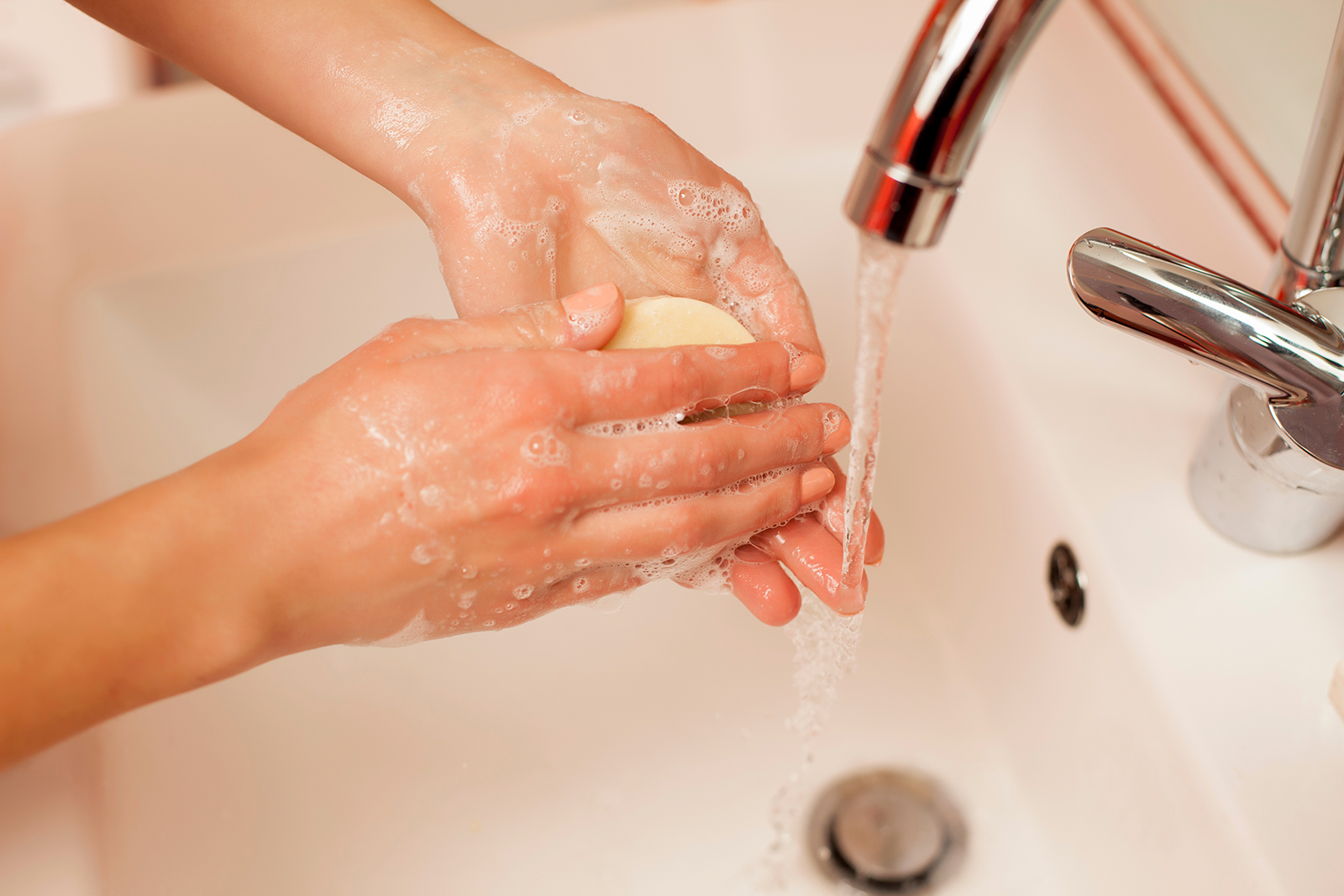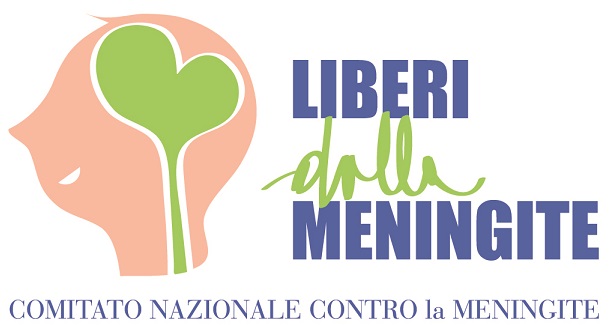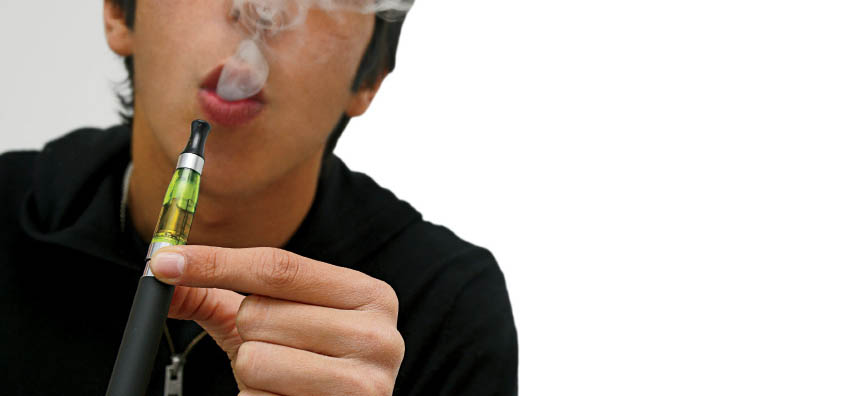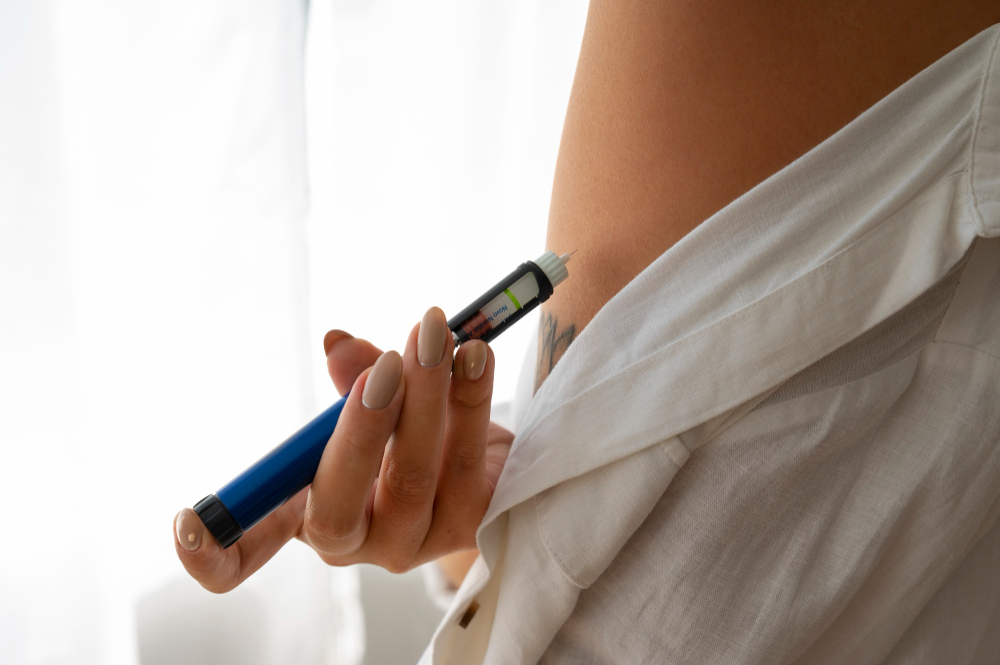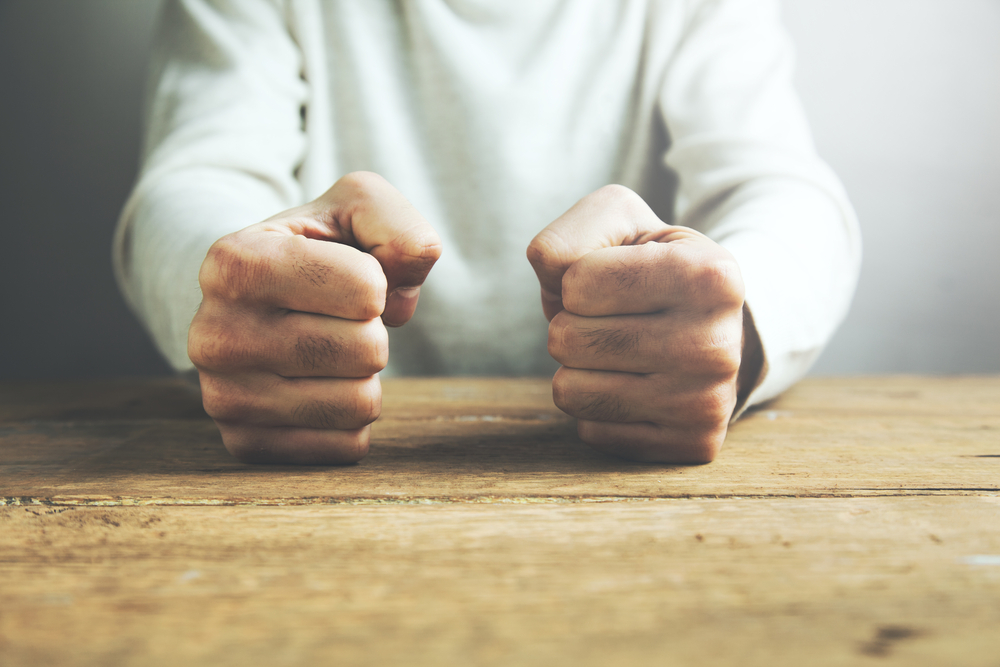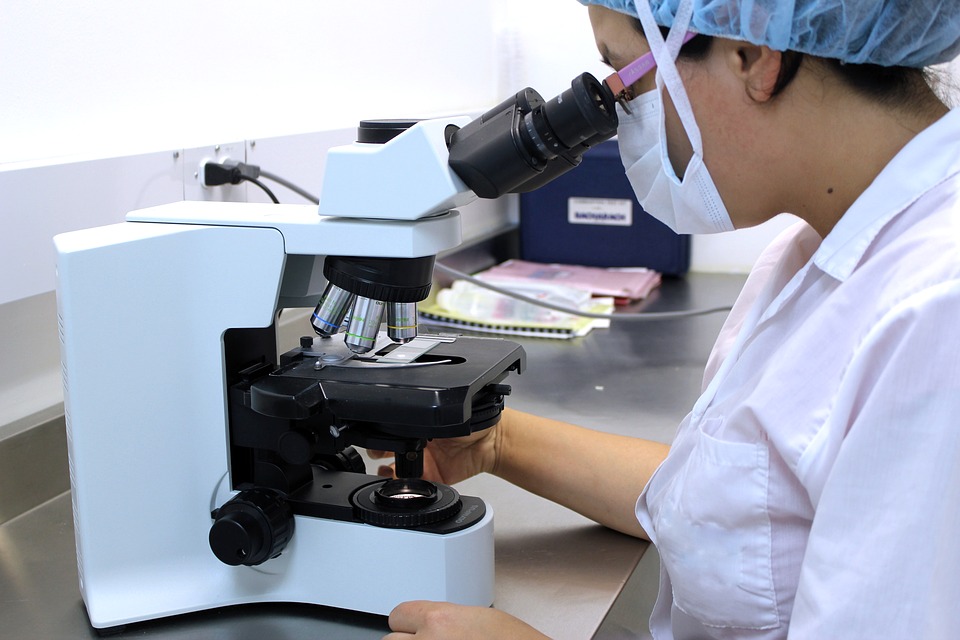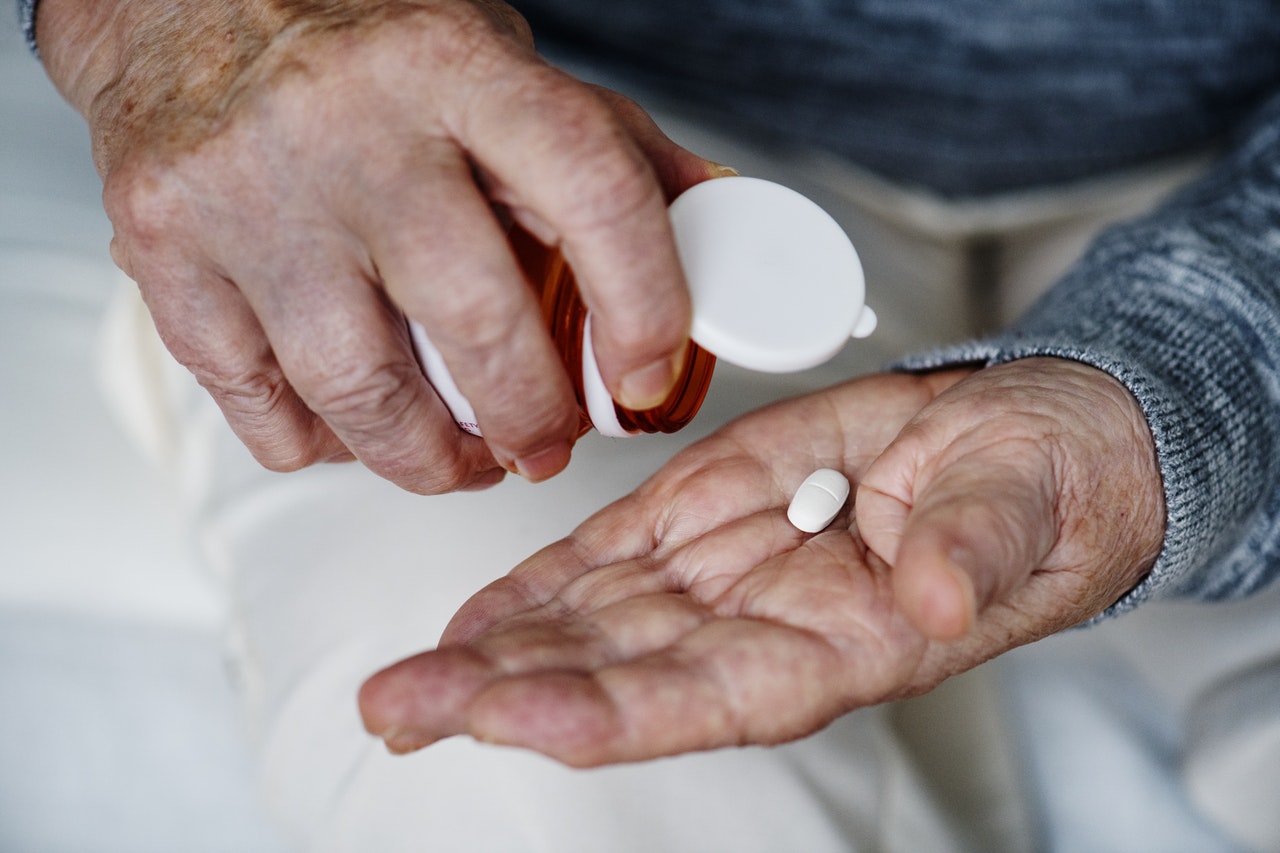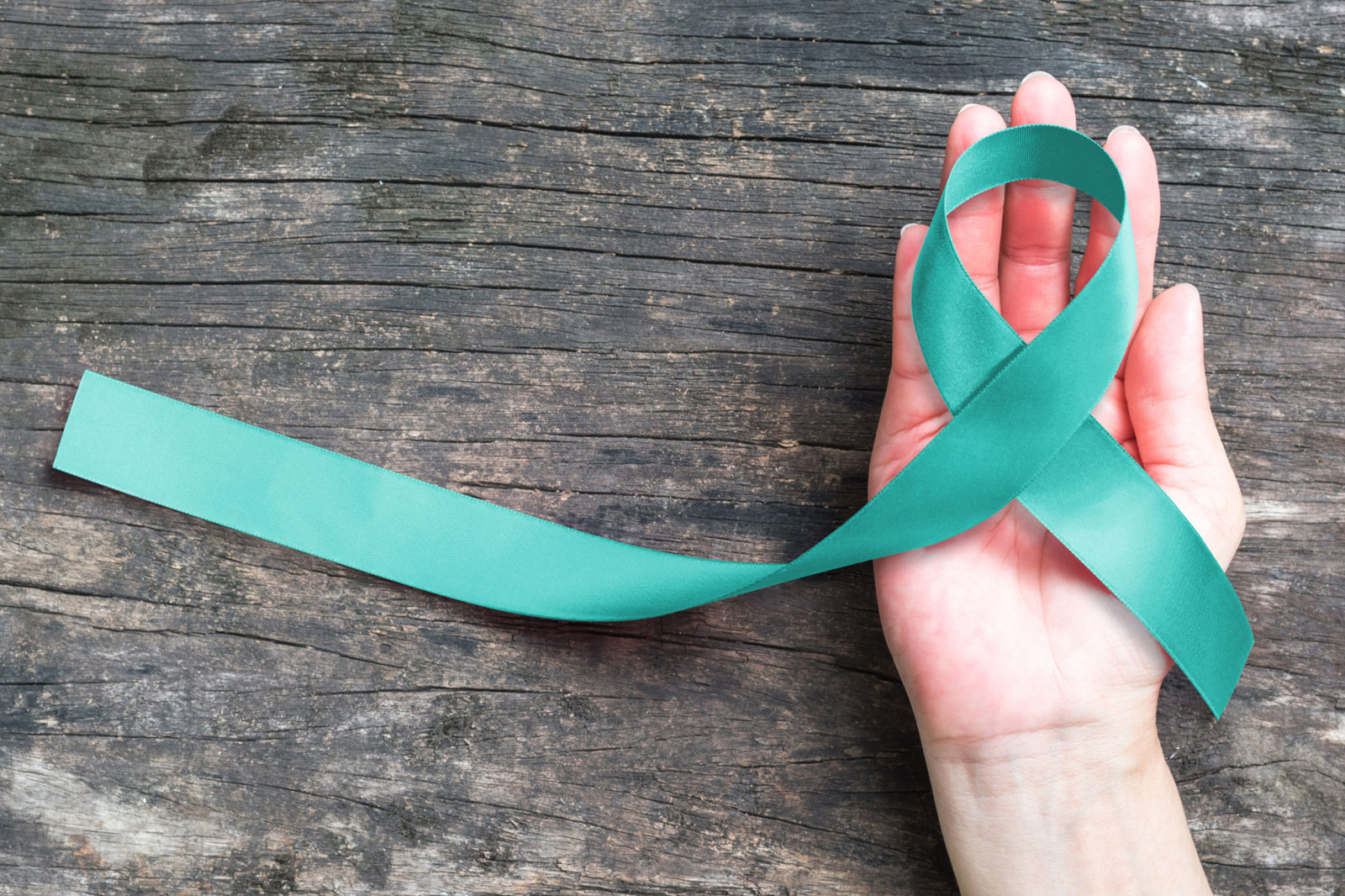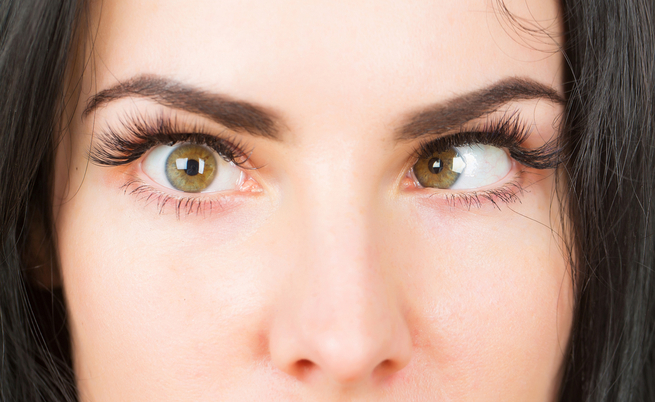Un nuovo video podcast di My Special Doctor: “L’insulina settimanale” a cura del Dott. Diego Carleo


Un nuovo video podcast di My Special Doctor: “L’insulina settimanale” a cura del Dott. Diego Carleo
Un nuovo video podcast di My Special Doctor: “I nuovi farmaci in diabetologia” a cura del Dott. Diego Carleo
Un nuovo video podcast di My Special Doctor: “Le Glifozine” a cura del Dott. Diego Carleo
Un nuovo video podcast di My Special Doctor: “La Fisioterapia nel Paziente Diabetico” a cura della Dott.ssa Arianna Morabito
Un nuovo video podcast di My Special Doctor: “Paziente e curante di fronte al diabete come malattia cronica” a cura della Dott.ssa Marisa D’Arrigo – Psicologa Analista
Un nuovo video podcast di My Special Doctor
a cura della Dott.ssa Nutrizionista Maria Chiara Villa e del Dott. Pediatra Piercarlo Salari con tanti consigli e indicazioni utili per Adulti e Bambini
Un nuovo video podcast di My Special Doctor dedicato a “Perché è importante ridurre il consumo di sale”.
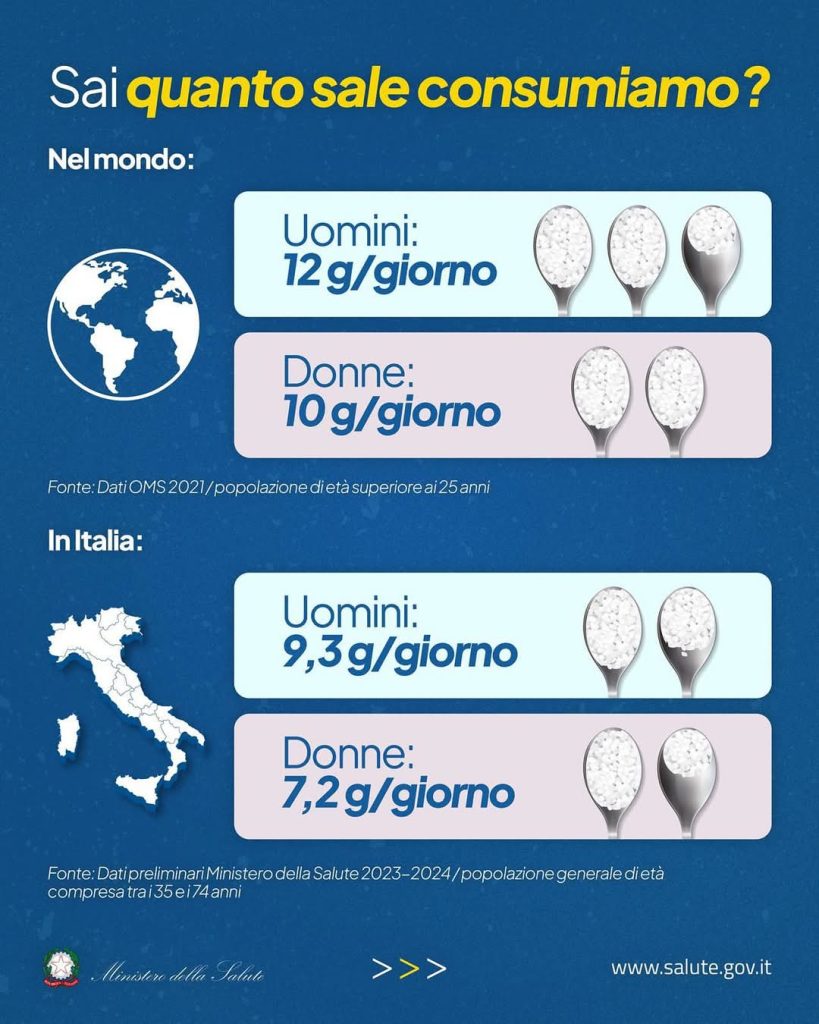
Un nuovo video podcast di My Special Doctor dedicato alla comorbidità Neurologiche nel Diabete
Un nuovo video podcast di My Special Doctor dedicato sulla Terapia Nutrizionale
Un nuovo video podcast di My Special Doctor dedicato sulla Terapia Nutrizionale Chetogenica
Un nuovo video podcast di My Special Doctor dedicato alla steatosi epatica nel paziente diabetico
Naples and China are getting closer: this time thanks to traditional Oriental medicine meeting Western medicine. On Wednesday, November 27, an agreement was signed linking the digital platform www.myspecialdoctor.it with the Henan University, establishing a partnership that includes a section dedicated to traditional Chinese medicine and resource exchanges hosted on the MySpecialDoctor platform, which was created in Naples and conceived by Luigi Martinucci, Giulio Mancino, and Massimiliano Ascolillo. The platform has already formed a partnership with the Federico II University on the topic of “risk management in medical practice” and is developing collaborations with healthcare institutions in Campania and the rest of Italy.
On November 27, 2024, at the headquarters of the Chinese Sports and Culture Association “Tuhe” in Naples, a streaming event took place during which a partnership was signed between the digital platform My Special Doctor and Henan University of Chinese Medicine (HUCM) with the aim of fostering a comparative study between Western and Eastern medicine.
The digital platform My Special Doctor strengthens its position with a new partner, driven by the common goal of disseminating knowledge and scientific data. In this context, the platform’s editorial and communication expertise merges with the academic studies and scientific research of the Chinese University, promoting continuous cultural updates and reciprocal knowledge exchange.
The collaboration agreement with an organization boasting 4 campuses, 18 schools and hospitals, over 22,000 students, and a highly qualified faculty fits perfectly into the company’s strategy.
Thanks to a selected team of medical experts, nutritionists, and trainers, My Special Doctor helps to spread traditional medicine practices, such as Taijiquan, Qigong, and Tuina, on an international level.
Among the main research centers, those focused on traditional Chinese pharmacology, Chinese osteopathy, acupuncture, and moxibustion stand out.
This initiative, therefore, represents a significant innovation in the global medical landscape, also becoming a reference point for Chinese communities worldwide.
“In detail,” stated Luigi Martinucci, administrator of My Special Doctor, “the platform will provide healthcare professionals with a large number of special accounts, usable as ‘Digital Clinics.’ Doctors and professionals will thus be able to provide consultations to Italian, Chinese users and Chinese communities in need of assistance and medical care.”
Through this collaboration, My Special Doctor has created a bridge between two seemingly distant but complementary worlds, uniting technology, culture, and medicine.
A new video podcast from My Special Doctor
by Nutritionist Dr. Maria Chiara Villa with plenty of useful tips and guidance for Adults and Children
Recently, a conference titled “Taijiquan in the treatment of Neurodegenerative Diseases – Scientific Evidence – Experiences in Comparison” was organized by the Minerva Physiotherapy and Rehabilitation Center and by Master Jia Jingquan of the Tuhe Association of Naples.
I had the opportunity to participate in this interesting event both as a doctor and as a practitioner of the ancient discipline of Taijiquan, and I thought I would share with interested readers a summary of the presentations included in the conference program.
In the opening remarks, Dr. Oreste Caporale, specialist in Hygiene and Preventive Medicine, emphasized the importance of prevention through proper dietary habits and regular physical activity, as extensively demonstrated by the latest national and international clinical studies on longevity and long-term quality of life.
Particularly interesting and current was the connection with Professor Zhu Jianfei, Director of the International Training School of the Henan University of Traditional Chinese Medicine, who reminded the audience of the great opportunity offered by cultural exchanges between the School of Traditional Chinese Medicine at Henan University and the Italian Chinese Cultural Sports Association Tuhe – currently the Italian Department of the International Training School of Henan University – aimed at promoting teaching, research, and medical care, including the culture of Taijiquan.
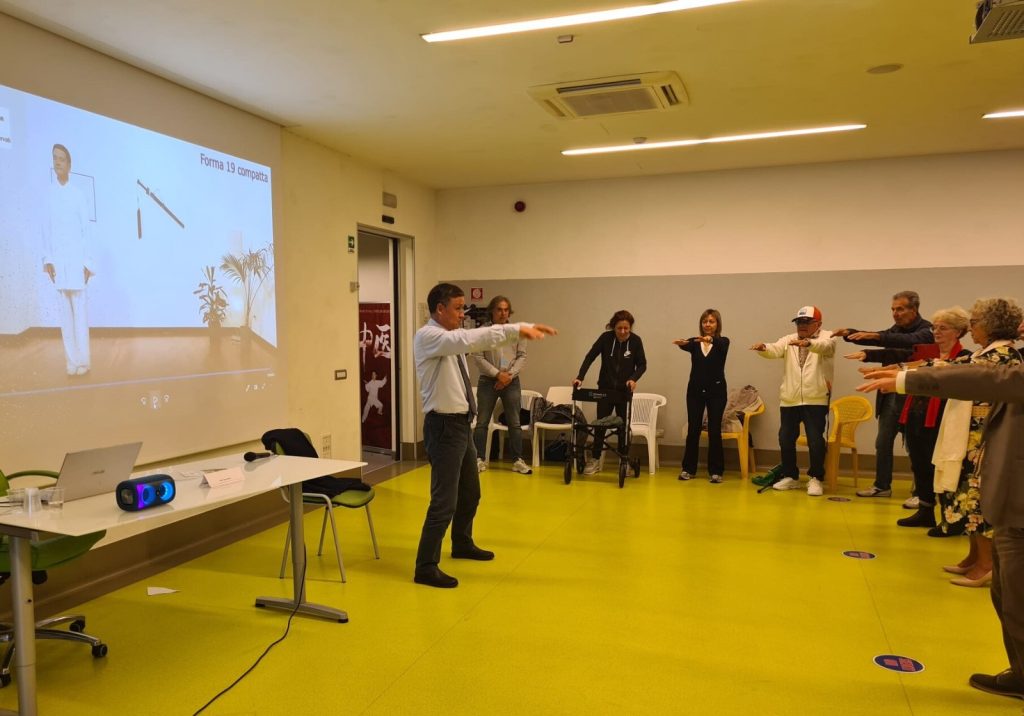
Professor Alessandro Tessitore, Director of the UOC Neurology and Parkinson’s and Movement Disorders Center at the Luigi Vanvitelli University Hospital, emphasized the importance of physical activity and exercise in international recommendations for the treatment of Parkinson’s disease. He included the practice of Taijiquan among alternative and/or complementary therapies, within motor activities that positively influence the quality of life of people affected by this condition.
Professor Ennio Del Giudice, former professor of Child Neuropsychiatry at the University of Federico II in Naples, illustrated the scientific evidence available regarding the beneficial effects of Taijiquan, noting that PubMed records about 2600 articles related to it. He then analyzed in detail a study published in the New England Journal of Medicine on the effectiveness of this discipline in improving postural stability in Parkinson’s disease patients. He also mentioned two recent articles published this year, which show how, following the practice of Taijiquan, patients experience increased cognitive efficiency and an increase in the volume of gray matter in the brain areas responsible for memory. Finally, he presented a study, also broadcast by the BBC, published in the official journal of the British Society of Neurology, which confirms the long-lasting benefits of Taijiquan on both motor and non-motor symptoms of Parkinson’s disease.
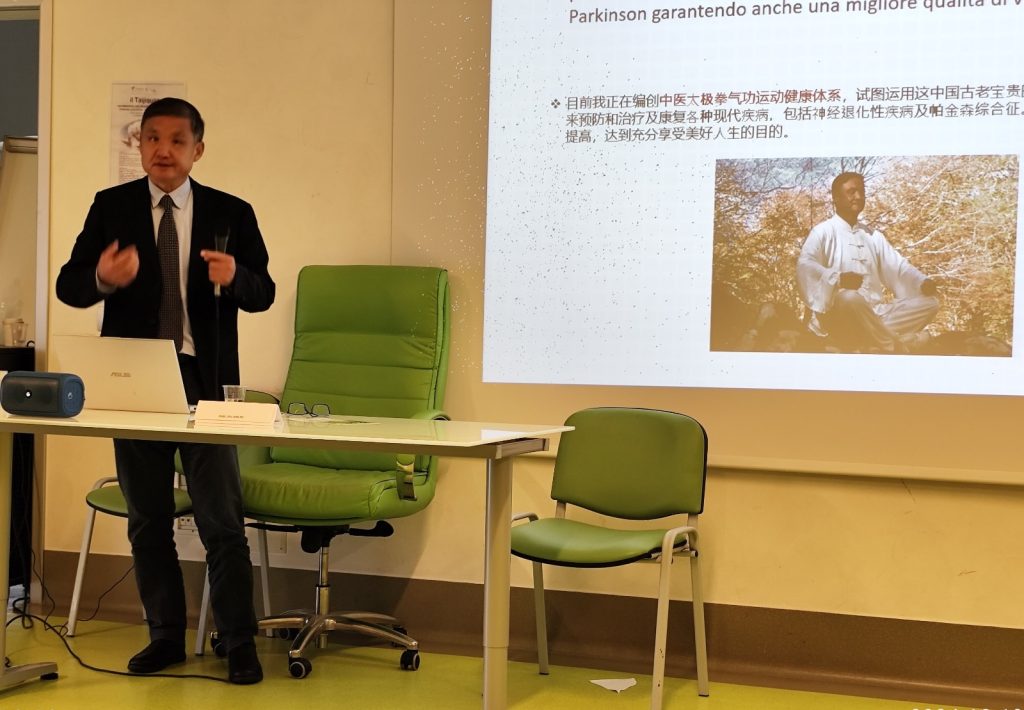
The presentations by Dr. Maria Teresa Giamattei, Alberto Battaglini, and Maria Valeria Capone, specialists in Physical Medicine and Rehabilitation, reiterated the need for an intervention program that is structured and integrated with the entire medical-rehabilitation process and personalized, i.e., tailored to the specific needs of the individual patient.
Dr. Rosario Savino, Child Neuropsychiatrist and expert in Psychoneuroendocrinology, discussed the value of the holistic conception of the individual, especially if they are dealing with a pathological condition. He also cited a study demonstrating that the practice of Taijiquan can increase endogenous opioids, thus reducing the pain perception experienced daily by Parkinson’s patients.
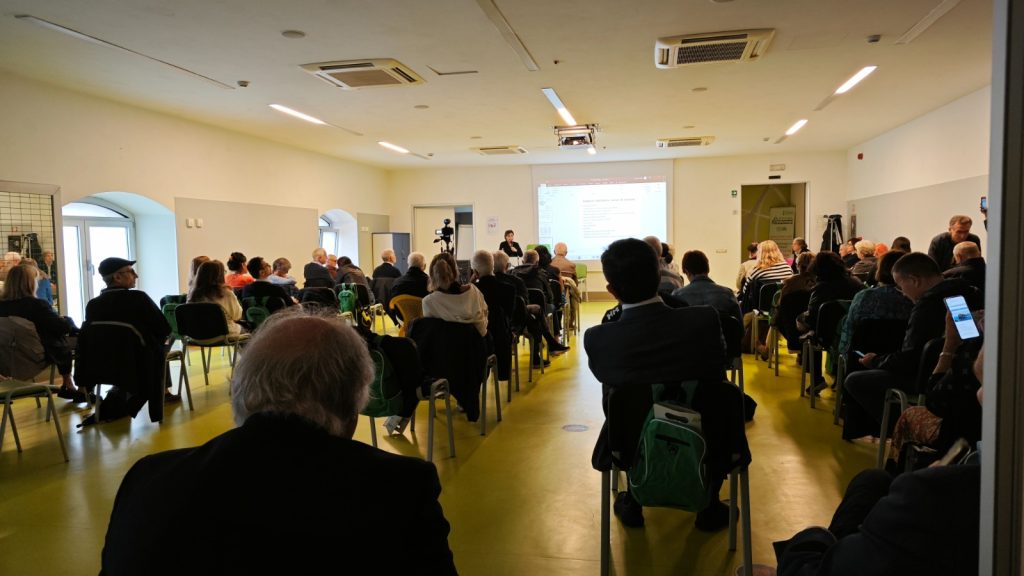
The event concluded with the intervention of Master Jia Jingquan, teacher of Taijiquan, Qigong, and Tuina. In the first theoretical part, he explained that Taijiquan includes the concepts of ancient traditional Chinese culture and has been listed as an UNESCO Intangible Cultural Heritage since December 2020. In ancient times, Taijiquan was a martial art for self-defense and combat, while today it can be used in the holistic management of various pathologies, including neurodegenerative diseases. Master Jia Jingquan emphasized that Taijiquan is very different from other forms of physical activity – such as gymnastics, dance, or even physiotherapy – and explained why practicing this discipline can improve quality of life and psychophysical well-being. In the second part of his speech, he involved the audience by presenting his own method, which, through the use of Taijiquan and Qigong techniques, enables effective results even in Parkinson’s patients in a relatively short time. The exercises created by Master Jia Jingquan, if practiced regularly and continuously, improve both coordination and balance. They also help work on concentration and the internal visualization ability of one’s body, leading to a gradual state of awareness and physical and mental relaxation, which, coordinated with breathing, promotes a continuous flow of vital energy throughout the body.
Taijiquan can therefore be a valuable aid in the treatment, prevention, and rehabilitation of various diseases, including neurodegenerative conditions such as Parkinson’s, as has been widely demonstrated over the years by many research centers, including internationally.
Dr. Angela Francesca Crisanti
Medical Doctor
Specialist in Pediatrics
Postgraduate in Pediatric Neurology
PhD in Pediatric Sciences at the University of Bologna
A new My Special Doctor video podcast on Myopia in Children
A new My Special Doctor video podcast dedicated to Diabetes Mellitus
A new video podcast from My Special Doctor
curated by Dr. Maria Chiara Villa
There is time until 12:00 on September 25, 2024, to submit applications for participation in the Postgraduate Course in “Healthcare Risk Management and Patient Safety”, organized by the Department of Public Health at Federico II University and coordinated by Professor Maria Triassi. The aim of the course is to develop, experiment, and evaluate innovative management models on clinical risk and patient safety.
A presentation seminar for the Course (open to all) will be held on September 17, 2024, at 14:30 in the Aula Grande Nord – Building 19 of the Federico II University Hospital, located at Via Pansini, 5.
The training program aims to transfer a broader and more comprehensive culture on corporate Risk Management, enabling participants to identify and assess all the risk factors affecting the management of healthcare facilities, with the goal of coordinating the analysis, design, and evaluation of processes and procedures within corporate structures, considering the interaction of human factors with other dimensions of the system. This will help spread cognitive skills, which are essential in activating more effective and safer performances.
At the end of the course, participants will be able to define/improve/promote the reporting, detection, and analysis system for error-related data, manage sentinel events and adverse events, using appropriate relational and managerial skills (leadership, communication, listening abilities), conduct clinical audits, and carry out morbidity and mortality reviews.
Article on the Policlinico website:
https://www.unina.it/-/40662550-corso-di-perfezionamento-in-healthcare-risk-management-e-patient-safety-
Call for Applications and Forms:
https://www.unina.it/-/57805431-pe_sp_healthcare_risk_management_23-24
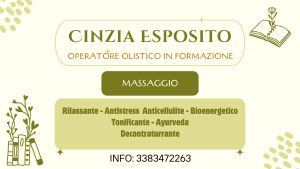
In an era characterized by hectic rhythms and daily stress, the search for effective methods to promote well-being and health has become crucial. Holistic medicine, which views the individual as a whole – body, mind, and spirit – has rediscovered and valued the practice of meditation as a powerful tool to improve quality of life. Let’s discover together how meditation, integrated into holistic medicine, can transform our health and well-being.

Meditation has ancient origins, dating back thousands of years, and has been practiced in various cultures and religions, from Buddhism to Hinduism, Taoism to Christianity. Despite the different techniques and approaches, the essence of meditation remains the same: a process of self-observation and inner connection aimed at achieving a state of awareness and tranquility.
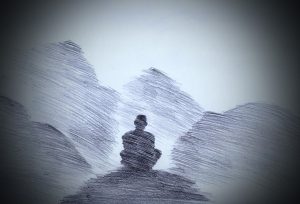
Holistic medicine is an approach to health that views the individual as an integrated unit of body, mind, and spirit. This philosophy is based on the idea that overall well-being depends on the harmonious balance of all these aspects. Holistic medicine uses a variety of therapeutic techniques, including natural treatments, physical exercise, balanced diet, and awareness practices like meditation, to promote health and prevent diseases.
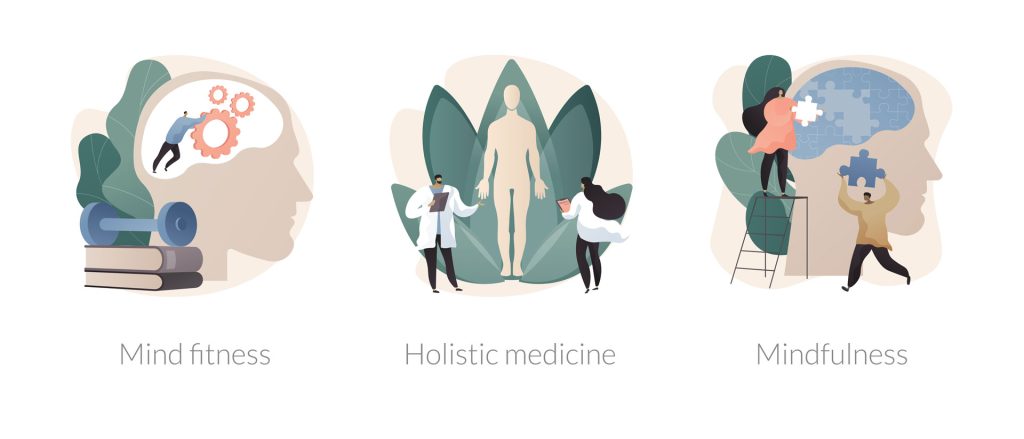
Meditation occupies a central role in holistic medicine due to its many scientifically proven benefits for physical and mental health. Let’s see how this practice can positively influence our well-being.
One of the most well-known benefits of meditation is its ability to reduce stress and anxiety. Scientific studies have shown that mindfulness meditation, which encourages full awareness of the present moment, can significantly reduce cortisol levels, the stress hormone. This leads to a decrease in muscle tension, improved sleep quality, and greater mental calmness.
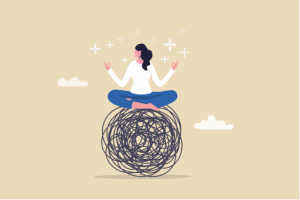
Regular meditation practice has been shown to have positive effects on cardiovascular health. Meditation helps reduce blood pressure and improves circulation, contributing to the prevention of heart disease and strokes. The reduction of stress and anxiety associated with meditation plays a key role in maintaining heart health.
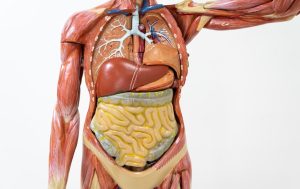
Meditation can also strengthen the immune system. Research has shown that meditation increases the activity of natural killer cells, which are crucial for fighting infections and tumors. Moreover, stress reduction and the increase in general well-being contribute to greater resistance to diseases.
Meditation also positively affects cognitive functions. Practices such as transcendental meditation and mindfulness improve concentration, memory, and decision-making ability. This happens because meditation increases the density of gray matter in the brain areas associated with learning and memory.
Meditation fosters lasting emotional well-being. Meditative practices help develop greater awareness of one’s emotions, promoting emotional regulation and resilience. Individuals who meditate regularly report a greater sense of happiness and satisfaction in daily life.
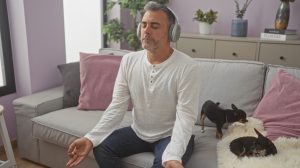
There are several meditation techniques that can be integrated into holistic medicine practice. Here are some of the different meditation techniques:
Integrating meditation into your daily routine doesn’t require much time or effort. Even just 10-20 minutes a day can make a big difference. Here are some practical tips to get started:
Meditation, as an integral part of holistic medicine, offers a comprehensive and natural approach to well-being. By integrating body, mind, and spirit, this ancient practice invites us to rediscover inner balance and live a more conscious and fulfilling life. In a world where stress and chronic diseases are on the rise, meditation emerges as a valuable tool to promote health and happiness.
Exploring and embracing meditation can represent a significant change in our approach to daily life. Beyond scientifically proven benefits, meditation offers us the opportunity to connect with ourselves at a deeper level, bringing harmony and serenity into our lives. The spread of articles promoting these practices can raise public awareness and encourage a more holistic and conscious approach to health and well-being.
By Cinzia Esposito, 2024

In the fast-paced world of modern life, the pursuit of balance and well-being has become a priority for many. Among the various holistic therapies that promise relief and healing, Ayurvedic massage stands out for its deep connection with ancient tradition and philosophy. Rooted in Indian Ayurvedic medicine, this massage offers not only physical relaxation but also a journey towards mental and spiritual harmony. Let’s explore the roots, techniques, and benefits of this millennia-old practice.
The Roots of Ayurveda
Ayurveda, meaning “the science of life,” is a system of traditional medicine that originated in India over 5,000 years ago. Based on sacred texts such as the Vedas, Ayurveda is distinguished by its holistic approach to health, integrating body, mind, and spirit. Ayurvedic philosophy holds that every individual is unique, and health is the result of a harmonious balance between the three doshas: Vata, Pitta, and Kapha.
Three Dosha (Dynamic Awareness)

Vata: Represents the elements of air and space. It governs movement, including blood circulation and the nervous system.
Pitta: Associated with the element of fire, it regulates metabolism, digestion, and body temperature.
Kapha: Comprising earth and water, it influences body structure and emotional stability.
Imbalances between these doshas can cause diseases and disorders, and this is where Ayurvedic massage comes in to restore harmony.
Techniques of Ayurvedic Massage
Ayurvedic massage is not a one-size-fits-all treatment; it varies based on an individual’s constitution and specific imbalances. The main techniques include:
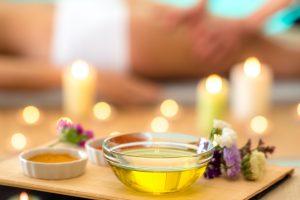
Abhyanga is a massage using medicated warm oils. It is performed with long, fluid strokes, synchronized with the breath. The oils used are selected based on the dominant dosha of the person and may include herbs and spices like turmeric, sandalwood, and neem.
Benefits of Abhyanga:
Reduces stress and promotes deep relaxation.
Improves blood and lymphatic circulation.
Nourishes the skin and tissues, preventing aging.
Promotes detoxification of the body.
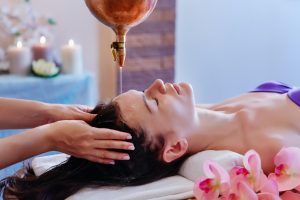
Shirodhara is a technique where a continuous stream of medicated oil is poured onto the forehead, particularly on the “third eye” area. This treatment is known for its ability to calm the mind and alleviate deep stress.
Benefits of Shirodhara:
Alleviates anxiety and tension.
Improves sleep quality.
Stimulates cognitive function and mental clarity.
Balances the nervous system.
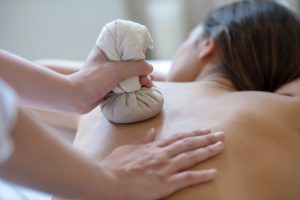
Pinda Sweda (SPA Italia Wellness) uses heated herbal pouches to massage the body. These pouches, called bolus, are filled with medicinal herbs and spices that are heated and applied with specific pressures.
Benefits of Pinda Sweda:
Reduces muscle and joint pain.
Improves flexibility and mobility.
Detoxifies and revitalizes the body.
Promotes energy circulation.
General Benefits of Ayurvedic Massage
In addition to the specific benefits of various techniques, Ayurvedic massage offers a wide range of advantages for overall health and well-being:
Relaxation and Stress Reduction: The use of medicated oils and massage techniques fosters deep physical and mental relaxation, reducing cortisol levels, the stress hormone.
Improved Circulation: The manipulations improve blood and lymphatic circulation, contributing to better oxygenation and nourishment of tissues.
Detoxification: The oils and Ayurvedic techniques help eliminate toxins accumulated in the body, improving kidney and liver function.
Boosting the Immune System: Stimulating energy points and improving the flow of vital energy strengthens the body’s immune defenses.
Psychophysical Well-being: Ayurvedic massage restores the balance between body and mind, promoting a sense of overall well-being and improving quality of life.
A Personalized Experience
One of the distinguishing aspects of Ayurvedic massage is its customization. Before beginning the treatment, the Ayurvedic practitioner conducts a thorough assessment of the individual’s constitution and imbalances through a detailed medical history and observation of physical and behavioral signs. This allows the treatment to be tailored to the person’s specific needs, ensuring that each session is unique and aimed at restoring inner balance.
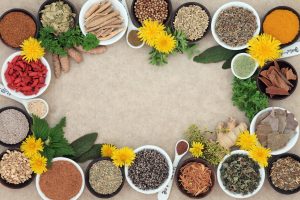
Ayurveda is not limited to massage; it is a lifestyle that promotes health through diet, exercise, meditation, and other daily practices. Integrating Ayurvedic massage into your routine means embracing a holistic view of well-being, where every aspect of life contributes to balance and health.
Diet
Ayurvedic diet is based on individual constitution and dosha imbalances. A personalized diet helps maintain internal balance and prevent illness. For example, a person with a predominant Vata dosha might benefit from warm, nourishing foods, while someone with Pitta dosha may find relief in fresh, hydrating foods.
Physical Exercise
Ayurveda encourages regular but moderate physical activity, adapted to individual needs. Practices like yoga and Tai Chi are particularly recommended as they promote balance between body and mind.
Meditation and Mindfulness Practices
Meditation is a pillar of Ayurveda. Techniques such as transcendental meditation and mindfulness help calm the mind, reduce stress, and improve concentration. These practices, when combined with Ayurvedic massage, offer a powerful tool for global well-being.
Conclusion
Ayurvedic massage is not just a beauty or relaxation treatment but a true holistic therapy that embraces the ancient wisdom of Ayurveda. Through personalized techniques and the use of medicated oils, this massage offers a path to balance and well-being, positively influencing not only the body but also the mind and spirit.
Incorporating Ayurvedic massage into your wellness routine can represent a significant shift in your quality of life. In a world increasingly focused on productivity and consumption, rediscovering and valuing ancient practices like Ayurveda invites us to live in harmony with ourselves and the environment around us. This millennia-old tradition offers valuable tools for tackling modern challenges with a conscious and integrated approach, promoting lasting health and deep well-being.
By Cinzia Esposito, 2024
Recently, I had the pleasure of participating in a webinar on: “Taijiquan and Parkinson’s Disease” organized jointly by Dr. Anna Michela Vitulano, President of the Parkinson Parthenope Association, Professor Ennio Del Giudice, former Director of the Specialization School in Child Neuropsychiatry at the University of Naples “Federico II” and President of the nonprofit association Neapolitan Brain Group, and myself: Master Jia Jingquan, Ambassador for the International Promotion of Taijiquan Culture.
After the opening remarks, there was an engaging presentation by Professor Alessandro Tessitore, professor of Neurology at the School of Medicine of the University of Campania “Luigi Vanvitelli” and Director of the Parkinson’s Disease and Movement Disorders Center. He emphasized that there are around 2,500 studies in the literature demonstrating Taijiquan’s preventive and therapeutic value in a wide range of chronic diseases. Professor Ennio Del Giudice presented on the topic, “Tai Ji Quan for People with Parkinson’s Disease: Evidence from Scientific Literature.” Among the approximately 150 studies on Taijiquan and Parkinson’s disease on PubMed, he highlighted one, published in the prestigious medical journal The New England Journal of Medicine, in which a group of patients already on drug therapy practiced a specific Taijiquan program for 3–6 months, achieving significant improvements in tremor, posture control, and balance, with a reduction in falls. The study also recorded benefits in cognitive functions.
Following Professor Del Giudice’s presentation, which illustrated with extensive data how practicing this ancient discipline positively affects human health, my personal contribution aimed to explain the reasons behind these results.
Taijiquan is an ancient Chinese martial art that integrates character and physical development with the personal challenges typical of martial arts, generating a special energetic activity. It embodies historical-philosophical principles related to Buddhism, Confucianism, and, largely, Taoism. The synthesis of all this is expressed in a movement of great beauty that stimulates the aesthetic sense of both practitioners and observers. This unique quality was universally recognized on December 17, 2020, when UNESCO added this art to the Representative List of the Intangible Cultural Heritage of Humanity. Taijiquan strongly integrates self-awareness and mindful attention with bodily movements (joints, muscles, internal organs). Physical practice with light, continuous, and “spiral” movements, combined with abdominal breathing and mental focus, stimulates various body systems. This synergy promotes blood and fluid flow and strengthens Qi (the life force in Traditional Chinese Medicine), thus activating natural self-healing functions. When the mind is calm and the body relaxed, the nervous system can generate impulses that produce non-automatic movement, constantly guided by intention and awareness of one’s body in space, resulting in efficient, balanced, and coordinated movement.
Specifically, in practicing Taijiquan, one is required to maintain a calm mind, breathe naturally, look inward, and keep the body balanced. After starting the exercise, movements should be gentle and slow, consistent and coordinated, with alert attention to maintaining a stable center of gravity. The practice then progresses gradually from easy to challenging, from slow to fast, so that the body can progressively engage in a full range of exercises.
Taijiquan was traditionally used for self-defense and combat. Today, we can use this precious cultural heritage in the holistic management of various conditions, especially Parkinson’s disease, as Taijiquan differs significantly from other types of physical activities, such as gymnastics, dance, or physical therapy. Because Parkinson’s is a neurodegenerative disease, the unique qualities of Taijiquan movements can effectively alleviate its symptoms: early tremors, limb stiffness, hypokinesia, gait abnormalities, falls, and cognitive and behavioral issues. Symptoms may significantly and durably improve, especially in mild to moderate cases, as supported by rigorous studies from the United States and the United Kingdom.
In my experience with people affected by Parkinson’s disease, I have developed a method that, by using Taijiquan and Qigong techniques, produces noticeable results in a relatively short time. This approach, which significantly improves coordination and balance through concentration and internal visualization, can reduce both the frequency of falls and the severity of tremors, allowing patients to regain some functional autonomy—a sense of independence that also translates into improved self-esteem.
Some techniques proposed for patients with Parkinson’s:
With these simple techniques repeated several times, according to my experience, visible and evident results can be achieved after just a few weeks of practice. The type of instruction is tailored to the patient’s condition. For mild cases, classes can be group-based, while in more advanced stages of the disease, individual instruction becomes essential.
I believe that, in many cases, Taijiquan practice can lead to a significant improvement in quality of life, particularly for people with motor disabilities, such as patients with Parkinson’s disease.
Master Jia Jingquan

OSTEOPATIS

ACUPUNCTORS, HOMEOPATHIC MEDICINE, TRADITIONAL CHINESE MEDICINE

DENTIST

DENTAL HYGIENIST, NATUROPATHY
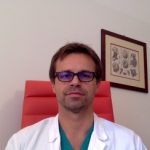
NEUROSURGEONS
Orthopedists, Basic Doctors
Coroner, Certifying Doctor, Basic Doctors
Aesthetic Doctors, Basic Doctors
Aesthetic Doctors, Plastic Surgeons, Basic Doctors
